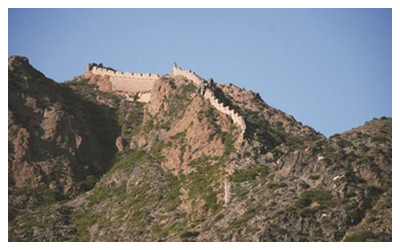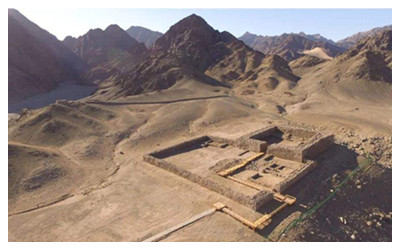- Home
- Province Guide > Inner Mongol >
Gaoque Fortress

Gaoque Fortress stands at the junction of the northern Dabatu Valley and the western Chagan Valley in Bayannur of Inner
Mongolian Region. In 306BC, King Wuling of Zhao State defeated the northern Linhu and Loufan tribes. Thereafter, he ordered that the Great Wall should be built to consolidate the northern border. The defense line runs from Dai (today's Yuxian County of Hebei Province), and ends at Gaoque Fortress at the southern foot of Langshan Mountain.
As the western end of the Great Wall of Zhao State, the fortress occupied an important position.The fortress is surrounded by mountain ridges on the western, northern, and eastern sides, while to the south stretches the vast Hetao Plain. Without the fortress, the northern Huns on horseback could easily go southward to the plain, and then invade Chang'an, capital city of Han Dynasty (202 BC- 220 AD), which is about 1,000 kilometers away. Thus, the Gaoque Fortress protected a vital passage in ancient times. The Huns attempted to invade Han Dynasty territory, but were blocked by the fortress.

"Gaoque" literally means high gate towers in English. It is inferred that its name comes from the two dark red peaks on either side of the Chagan Valley, which resemble two gate towers when seen from afar.
Gaoque Fortress is composed of two small cities. The square Northern City has a side length of 40 meters. The wall ranges from 4 meters to 6 meters high. The top is 4 meters thick, and the bottom is 6 meters thick. The outside of the wall is made from larger boulders, and the inside filled with small rocks and sand. You can ascend to the city along stone steps at the northeast corner. In the middle of the southern wall is the entrance. The rectangular Southern City is 64 meters long and 48 meters wide. It is here that cultural relics such as iron axes, arrows, and armor were unearthed. The entrance lies to the east of the southern wall. The wall is about 2 meters thinner and 2 meters shorter than the Northern City.
The different architectural styles indicate that the two cities were from different historical periods. It is thought that the Northern City was built by King Wuling of Zhao during the Warring States Period, while the Southern City was built during the Han Dynasty. Ruins of houses have been found in both cities. Nowadays, the fortress has partly fallen into disrepair, but most parts are well-preserved.
On the gentle slope outside the fortress, a stone wall runs from northeast to southwest. The wall is about 300 meters long, and is made of stone slabs. The wall is connected with a square stone building over the hill to the west of the fortress. The building is believed to be the site of a beacon tower. After thousands of years of natural erosion, most parts of the wall have collapsed. But the outline can still be made out.
Ascending the fortress, you will have a panoramic view. You can see the nearby valleys, mountain ridges, and the Great Wall of the Zhao State coming from afar. It gives you a strong feeling of the vicissitudes of history.
Travel Tips
Add: Huhewenduer Town, Urat Rear Banner, Bayannur, Inner
Mongolia.
Opening Hours: 0800-18:00
Entrance Fees: CNY50
 Gaoque Fortress stands at the junction of the northern Dabatu Valley and the western Chagan Valley in Bayannur of Inner Mongolian Region. In 306BC, King Wuling of Zhao State defeated the northern Linhu and Loufan tribes. Thereafter, he ordered that the Great Wall should be built to consolidate the northern border. The defense line runs from Dai (today's Yuxian County of Hebei Province), and ends at Gaoque Fortress at the southern foot of Langshan Mountain.
Gaoque Fortress stands at the junction of the northern Dabatu Valley and the western Chagan Valley in Bayannur of Inner Mongolian Region. In 306BC, King Wuling of Zhao State defeated the northern Linhu and Loufan tribes. Thereafter, he ordered that the Great Wall should be built to consolidate the northern border. The defense line runs from Dai (today's Yuxian County of Hebei Province), and ends at Gaoque Fortress at the southern foot of Langshan Mountain. "Gaoque" literally means high gate towers in English. It is inferred that its name comes from the two dark red peaks on either side of the Chagan Valley, which resemble two gate towers when seen from afar.
"Gaoque" literally means high gate towers in English. It is inferred that its name comes from the two dark red peaks on either side of the Chagan Valley, which resemble two gate towers when seen from afar. Ask Questions ?
Ask Questions ?